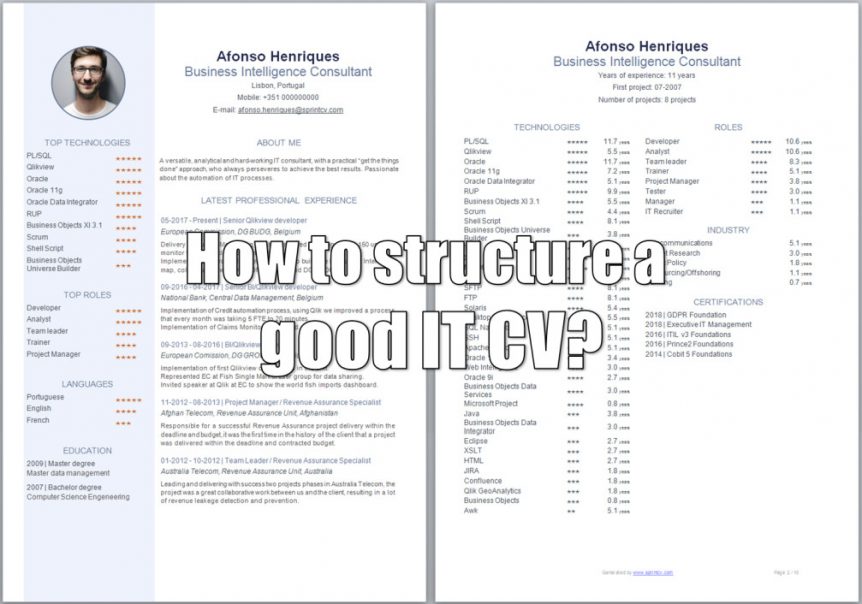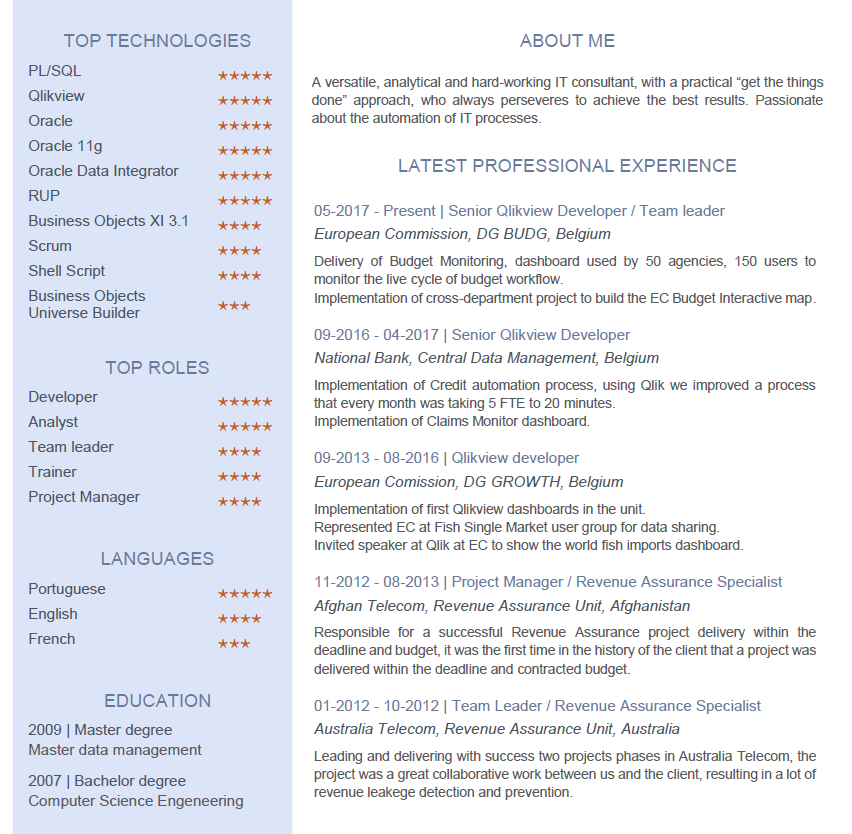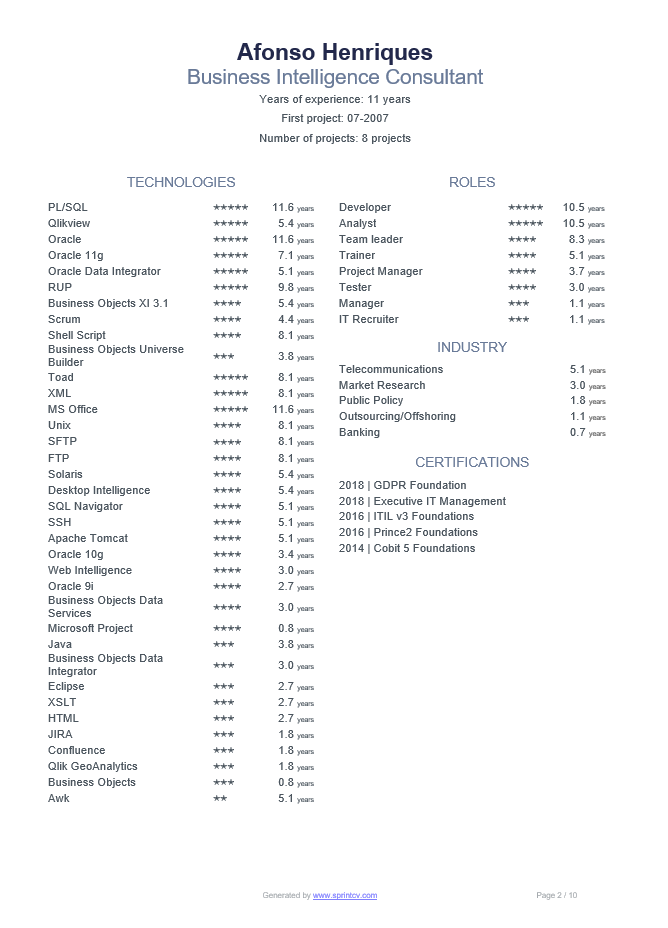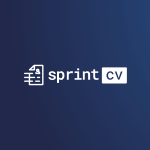
How to structure a good IT CV?
We all know how vital a CV is. Since it’s the “first impression” and the first point of contact with the prospective employer, you should be very careful about how it is presented. Bottom line, it represents you.
Standing out in the IT industry can be daunting, specially because there are tons of highly-skilled IT professionals. What seems to be a difficult and confusing thing to do could be done easily if you only know “how” a CV should be written.
We have created a list of general questions that may put you at ease and give you better light on this topic before we move on getting things done. Stay tuned because at the end of this article we will reveal the secret recipe. Clue: it starts with the letter “s.” Sounds exciting, right?
What should you know (that you thought you already know)?
CV or Curriculum Vitae – yes we get it, you already know the meaning but please continue reading – is a Latin word for “course of (one’s) life.” Though it simply means it’s all about you, one must be thorough in choosing only the parts to be highlighted. The logic is to list down what we want IT recruiters to know, not to confuse them.
In writing an IT CV, should it be truthful or impressive?
This is a common misconception. You may present awe-inspiring experience, extraordinary skills and you wonder why you didn’t land the job. Why? Most of the cases, because you don’t have what the company is looking for.
So your CV should be truthful, yet relevant to the role. Skills and experiences that are related to the job description should be highlighted with details on “what you really know” rather than putting flamboyant and pretentious summary that really didn’t happen in your career. An HR or an employer may put you in a bad light and your CV right in the trash if they feel that you were not what you are saying.
Is there a standard way of writing an IT CV?
“How to write an IT CV?”, “Samples of a good IT CV”, “Basic principles to build a good CV for the IT industry” – do these keywords ring a bell to you? People spend tons of hours researching for steps to increase their resume response rate. Surprisingly, there is no correct way to do it. Two things we know for sure: it needs to go directly to the point and, most of all, suit your needs.
Ever wondered how the world’s tallest building has effectively been constructed and still standing up to this date? The answer is “structure” – and this is exactly what you should apply to your CV.
How to structure a good IT CV?
Did you know that the first page is the most crucial part of your CV? Who has time to read 15 pages x 200? We don’t! The structure should be professional, concise, and comprehensive.
Personal Details
The first part should present who you are, literally. There are some cases of unsuccessful hiring just because of a piece of missing personal information. Oh, no!
-
- Your name should be at the very top and the highlighted part of the CV followed by your title.
-
- This is an interview and you are not a missing person, it is not required that you indicate your complete address.
- Putting a mobile or a contact number is the second most important part. This serves the purpose of the CV: to get the employer to call you for an interview.
-
- A professional-looking email address also functions as your contact detail. If you still have your CuTi3F0r3V3R13@whatever.com email, don’t even think about including it in your CV.

About Me
The part where you can freely and fully discuss how you love gardening, that you have ten kittens, that your best friend’s name is John, and that you hate pineapples in pizza. Please, don’t be this person!
This section is best showcased in 2-3 lines where you give a glimpse of your personality at a professional level.
Here, we have an example from Sprint CV:
A versatile, analytical and hard-working IT Consultant, with a practical “get the things done” approach, who always perseveres to achieve the best results. Passionate about the automation of IT processes.
Latest Professional Experience
The first page is the most crucial part when it comes to structuring your CV. Go directly to the point and show your latest professional experience. For sure the interviewer wants to know your work history 10 years ago, but not on the first page!
As an IT professional you may have a long list of skills and experiences so how would it work? Take the example of the CV below from sprintcv.com: It puts a brief summary of the top technologies (PL/SQL, Qlikview, Oracle) and top roles (Developer, Analyst, Team Leader, Trainer), with corresponding efficiency level represented in star ratings. Languages and education. All of these relevant and significant areas to look at are in just one glance!

Technologies, Roles, Industry, and Certification
The next thing to look at is the second page of your CV where we put the complete list of your credentials. The goal is to provide the details in a clean and well-structured system helping the interviewer identify other aspects of your career which may also contribute to the role you are fulfilling to meet.
-
- Years of experience
-
- First project (date)
-
- Total Number of Projects
-
- Technologies (Oracle Data Integrator, RUP, Business Objects XI 3.1, Scrum, Shell Script, etc.)
-
- Roles (Project Manager, Tester, Manager, IT Recruiter, etc.)
-
- Industry (Telecommunications, Market Research, Public Policy, Outsourcing, etc.)
-
- Certifications
This structure will allow the recruiter to gain more knowledge on your level of expertise in key areas by using ratings (stars) with corresponding years of experience per item. This is a smart way to provide a clear scope on how effective you are in each technology, roles, and industry.

Professional Experience
After learning the principal aspects, the recruiter is now presented with your professional experience with in-depth and complete details of the following:
-
- Project name
- Job title
- Dates (start-end)
- Client (customer)
- Location
- Company (employer)
- Project achievements
- Project description
- Roles in the project
- Responsibilities in the project
- Technologies and methodologies used in the project
The goal is to impart an understanding of the history of your career and provide additional details on what the recruiter wants and needs to know in order to make the call for an interview.

Conclusion:

There is no secret to writing a good IT CV. It all lies in the structure. All years and tears of pure hard work, building your name and career in the IT industry will be put into waste if your credentials are not organized in a way that will be both beneficial to you and to the interviewer.
We know how tedious and difficult it is already to find new opportunities, nobody should experience this. Sprint CV takes care of everything for you regarding CV generation in an easy and automated way, saving you a lot of time.
Don’t miss out wonderful opportunities that await you, visit sprintcv.com for more details on how we can help you.